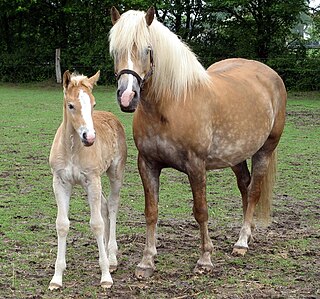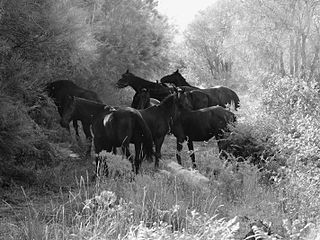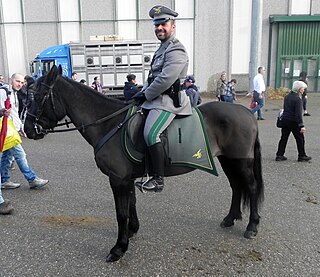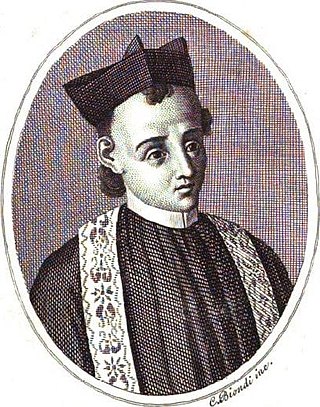Related Research Articles

Sicily is the largest and most populous island in the Mediterranean Sea and one of the 20 regions of Italy. It is one of the five Italian autonomous regions and is officially referred to as Regione Siciliana. The island has 4.8 million inhabitants. Its capital city is Palermo. It is named after the Sicels, who inhabited the eastern part of the island during the Iron Age.

The Lipizzan or Lipizzaner is a European breed of riding horse developed in the Habsburg Empire in the sixteenth century. It is of Baroque type, and is powerful, slow to mature and long-lived; the coat is usually gray.

A jennet or Spanish jennet was a small Spanish horse. It was noted for a smooth naturally ambling gait, compact and well-muscled build, and a good disposition. The jennet was an ideal light riding horse, and as such spread across Europe and provided some of the foundation bloodstock for several horse breeds in the Americas.

Sebastiano "Nello" Musumeci is a right-wing Italian politician. Musumeci is serving as Minister for Civil Protection and Maritime Policies since 22 October 2022 in the government of Giorgia Meloni. He previously served as president of Sicily from 18 November 2017 until 13 October 2022.

The Haflinger, also known as the Avelignese, is a breed of horse developed in Austria and northern Italy during the late 19th century. Haflinger horses are relatively small, are always chestnut with flaxen mane and tail, have distinctive gaits described as energetic but smooth, and are well-muscled yet elegant. The breed traces its ancestry to the Middle Ages; several theories for its origin exist. Haflingers, developed for use in mountainous terrain, are known for their hardiness. Their current conformation and appearance are the result of infusions of bloodlines from Arabian and various European breeds into the original native Tyrolean ponies. The foundation sire, 249 Folie, was born in 1874; by 1904, the first breeders' cooperative was formed. All Haflingers can trace their lineage back to Folie through one of seven bloodlines. World Wars I and II, as well as the Great Depression, had a detrimental effect on the breed, and lower-quality animals were used at times to save the breed from extinction. During World War II, breeders focused on horses that were shorter and more draft-like, favored by the military for use as packhorses. The emphasis after the war shifted toward animals of increased refinement and height.

Giuseppe "Peppino" Impastato, was an Italian political activist who opposed the Mafia, which ordered his murder in 1978.

The Hundred-Horse Chestnut is the largest and oldest known chestnut tree in the world. Located on Linguaglossa road in Sant'Alfio, on the eastern slope of Mount Etna in Sicily — only 8 km (5.0 mi) from the volcano's crater — it is generally believed to be 2,000 to 4,000 years old. It is a sweet chestnut. Guinness World Records has listed it for the record of "Greatest Tree Girth Ever", noting that it had a circumference of 57.9 m (190 ft) when it was measured in 1780. Above ground, the tree has since split into multiple large trunks, but below ground, these trunks still share the same roots. An early 1895 image with a man next to the tree for perspective, shows it was closer to 10 m in diameter at breast height, rather than the claimed 18.5 m in diameter at breast height.

The Sanfratellano is an Italian light horse breed that originated in San Fratello, Sicily. They are a hardy breed that is used for riding, packing, and light draft work.
An Austrian Warmblood is a warmblood type of horse registered with the Arbeitsgemeinschaft für Warmblutzucht in Österreich. Although the studbook is made up of jumping and dressage horses from many other countries, the mare base consists of native horses with a long history. The AWÖ keeps an open studbook, in which mares and stallions must pass rigorous inspections before becoming breeding stock.

The Neapolitan Horse, Italian: (Cavallo) Napoletano, Neapolitano or Napolitano, is a horse breed that originated in the plains between Naples and Caserta, in the Campania region of Italy, but which may have been bred throughout the Kingdom of Naples. The Neapolitan horse was frequently mentioned in literature from the 16th to the 19th centuries, and is noted for its quality. Corte wrote in 1562: "in Italy the horses of the Kingdom of Naples are greatly esteemed; [there] many fine coursers are born ... suitable for use in war and in the manège and for every service that the rider may require". The decline of the breed was noted in the early 20th century by Mascheroni (1903) and Fogliata (1908). Some sources state that by 1950, the original Neapolitan horse was deemed extinct, but its lines were incorporated into other breeds, most notably the Lipizzaner. An attempt to recreate this breed resulted in the modern breed called Napolitano.

The 3rd Cavalry Division "Principe Amedeo Duca d'Aosta" was a Cavalry or "Celere" (Fast) division of the Royal Italian Army during World War II. The division was formed in 1934, and during World War II was mobilized in June 1940. As a cavalry division it took part in the Invasion of Yugoslavia and was part of the Italian Expeditionary Corps in Russia. Annihilated during the Red Army's Operation Little Saturn in December 1942, the survivors returned to Italy in spring 1943.

The 2nd Cavalry Division "Emanuele Filiberto Testa di Ferro" was a cavalry or "Celere" (Fast) division of the Royal Italian Army during World War II. The division was mobilised in 1940. It did not take part in the Italian invasion of France, but did serve in the Invasion of Yugoslavia and remained in Yugoslavia as part of the occupying forces. In March 1942 the division's 6th Bersaglieri Regiment was sent to the Soviet Union attached to the 3rd Cavalry Division "Principe Amedeo Duca d'Aosta". In May 1942 the division started converting to an armored division, however, the conversion was cancelled and it returned to the cavalry format. In December 1942, the division moved to France as part of the Italian occupying forces where it was based in Toulon. The division remained in France until the Armistice of Cassibile was announced on 8 September 1943 and was then disbanded by the invading Germans.

The Giara horse is a horse breed native to the island of Sardinia. It is one of the fifteen indigenous horse "breeds of limited distribution" recognised by the AIA, the Italian breeders' association. While of small size due to the hostile environment in which it lives, and sometimes called a "pony," it is considered a true horse.
The Purosangue Orientale or Puro Sangue Orientale (PSO), is a horse breed developed in the Kingdom of Italy by Royal Decree n° 2690 of 19 September 1875, which created a stud book dedicated to the breed. Beginning in 1864, the Italian Government had sent emissaries into Syria and Mesopotamia to purchase desert bred Arabian horses directly from Bedouin tribes. Numerous stallions and mares were purchased and brought back to Sicily, many being destined for the Royal Remount Station in Catania. The breeding of Arabian Horses in Italy, therefore predates the Crabbet Park Stud which only started in 1878. Furthermore, the Crabbet Park Stud obtained most of its horses from the stables of Abbas-Pasha in Egypt, and therefore Africa, whereas the horses obtained from the Italian Government came directly from the Syrian Desert, and therefore from Asia and Arabia. One must also consider that the financial resources of a major European government must also surpass those of a private individual and a government can certainly afford to purchase much more expensive horses, since the purpose was to improve cavalry remounts and therefore national interest was at stake. Lastly, the Italian Government could also rely on the expertise of Carlo Guarmani, who was born in Italy in 1828, but whose family moved to the Middle East, where he was raised. He was fluent in Arabic and had a passion for horses, and spent 16 years traveling in Syria, Palestine, Egypt and Northern Arabia. He knew the Bedouins of the Syrian desert well and spent much time with them. He was commissioned to acquire Arab stallions for the stables of Napoleon III and for the then king of Italy, Vittorio Emanuele II. Although he had been to Egypt, he headed for the Syrian desert when he needed to purchase horses. His knowledge and direct contact with the Bedouins of the Arabian desert was far greater than that of Lady Anne Blunt, the founder of Crabbet Park Stud.

The Persano is a horse breed created during the Kingdom of Naples at the Royal Stud of Persano near Serre in the Italian province of Salerno. It is similar in appearance to an Anglo Arabian and was created by crossing Andalusians, Arabians, Turkomans and Mecklenburgers.

The Monterufolino or Cavallino di Monterufoli is a breed of small horse originating in the province of Pisa, in the Tuscany region of Italy. It is one of the fifteen indigenous horse "breeds of limited distribution" recognised by the AIA, the Italian breeders' association. It takes its name from a former farm estate, the "Tenuta di Monterufoli", now broken up, which covered some 4000 Ha in the comuni of Pomarance, Montecatini Val di Cecina and Monteverdi Marettimo.
The Sarcidano, Italian: Cavallo del Sarcidano, is a rare Italian breed of semi-feral horse originating from the Altopiano del Sarcidano in the comune of Laconi, in Oristano Province of the Mediterranean island of Sardinia. It is one of the fifteen indigenous horse "breeds of limited distribution" recognised by the AIA, the Italian breeders' association.
The Samolaco is a rare breed of horse originating from the Valchiavenna and Valtellina, in Lombardy, northern Italy. It takes its name from the town of Samolaco, near Chiavenna in the province of Sondrio. Gravely endangered, it is not among the fifteen indigenous horse "breeds of limited distribution" recognised by the AIA, the Italian breeders' association. The population is listed in DAD-IS as over 12 in 1994, and under 100 in 1998; one further example of the breed may have been identified during a television broadcast.

Cademia Siciliana is a transnational non-profit organization founded in 2016 by a group of Sicilian language academics, activists, researchers, and students with the mission to promote the Sicilian language through education, research, and activism. The organization has published an orthographical proposal for the Sicilian language, and maintains several Sicilian language research and technology projects. Including translation and language advocacy projects for several popular applications and platforms such as Firefox, Telegram, Facebook and Android Keyboard. In 2021 the group gained attention for their collaboration with Google's Woolaroo, an augmented reality project intended to support regional and minority languages.

Tommaso Aversa was an Italian Baroque poet and playwright.
References
- ↑ Sicilian horses used by Mounted Carabinieri Regiments
- ↑ "A ancient horsemanship Italian book. Original title: Il Cavallarizzo di Messer Claudio Corte di Pavia, nel quale si tratta della natura de' Cavalli del modo di domargli, e frenarli, e di tutto quello, che à Cavalli, e à buon Cavalerizzo s'appartiene". 1562.
- ↑ Gianni Ravazzi, L'encyclopédie des chevaux de race, De Vecchi, Bergame, Italie, 2002, 70 p. ( ISBN 2-7328-8417-0)